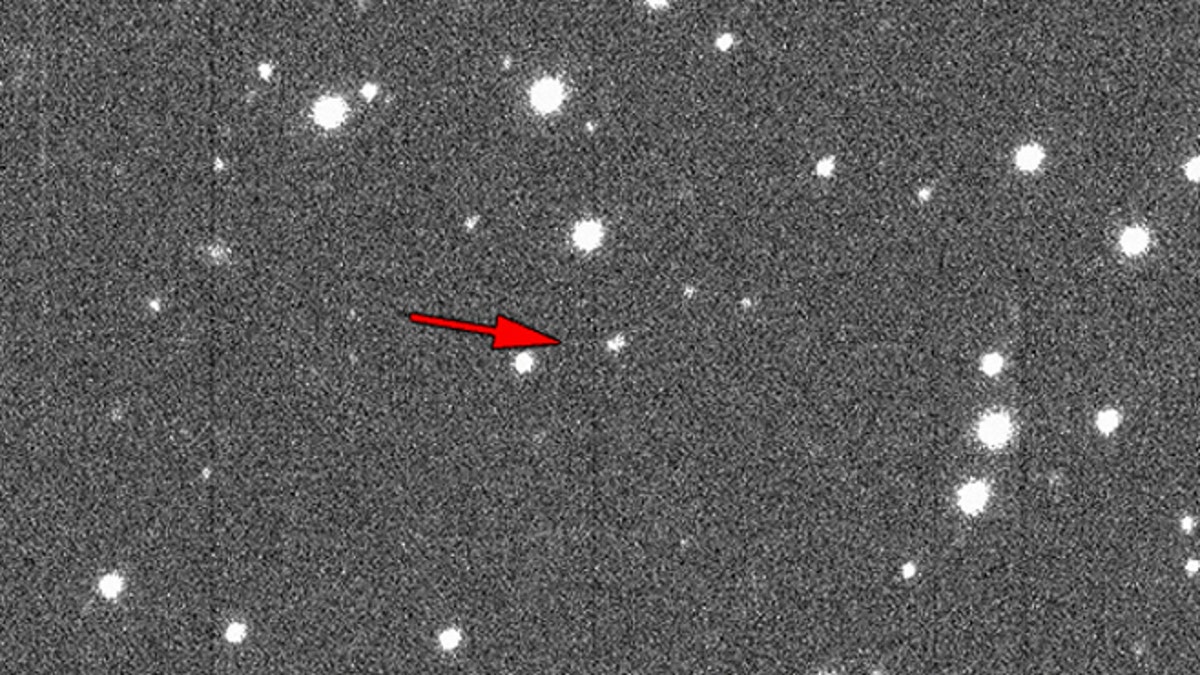
Asteroid 2013 MZ5 as seen by the University of Hawaii's PanSTARR-1 telescope. (NASA)
The good news: NASA has discovered the 10,000th near-Earth object (NEO).
The bad news: At least 100,000 are still out there.
PHOTOS: Russian Meteor Strike Aftermath
NEOs are asteroids and comets that approach Earth, coming within 28 million miles (45 million kilometers) of our planet during their orbit around the sun. The vast majority of these chunks of space rock and ice are harmless — they just fly right by, minding their own business, in well-defined, well-known orbits.
NEOs also come in a range of sizes, from the pipsqueak few-footers to the rather terrifying whopper, 1036 Ganymed, that measures 25 miles (41 kilometers) across.
And now NASA has discovered the 10,000th NEO — a 1,000 feet (300 meters) wide asteroid affectionately named 2013 MZ5.
“Finding 10,000 near-Earth objects is a significant milestone,” said Lindley Johnson, program executive for NASA’s Near-Earth Object Observations (NEOO) Program at NASA Headquarters. “But there are at least 10 times that many more to be found before we can be assured we will have found any and all that could impact and do significant harm to the citizens of Earth.”
That means there’s at least 100,000 of these (potentially) marauding space rocks still to be tracked down, a feat that NASA is tackling head-on.
PHOTOS: Top 10 Ways to Stop an Asteroid
The latest asteroid was spotted by the Maui-based Pan-STARRS-1 telescope as part of a NASA-funded, University of Hawaii-managed PanSTARRS survey. 2013 MZ5 is by no means a hazardous asteroid and is not expected to be any threat to Earth of the foreseeable future.
The discovery of 2013 MZ5 is the latest in a long line of NEO discoveries, most of which have been made by NASA projects over the last 15 years.
“The first near-Earth object was discovered in 1898,” said Don Yeomans, manager of NASA’s Near-Earth Object Program Office at the Jet Propulsion Laboratory (JPL) in Pasadena, Calif. “Over the next hundred years, only about 500 had been found. But then, with the advent of NASA’s NEO Observations program in 1998, we’ve been racking them up ever since. And with new, more capable systems coming on line, we are learning even more about where the NEOs are currently in our solar system, and where they will be in the future.”
Although many more space rocks remain to be found, it’s believed that the majority of big, potentially hazardous NEOs have been discovered. Of the 10,000 discoveries so far, roughly 1,000 are larger than one-kilometer across. From this size and up, should one hit Earth, it would have global consequences for the planet and all life on it. So far, none of these large objects pose a threat. Even better news is that only a few dozen of the largest NEOs remain to be found.
PHOTOS: NASA’s Asteroid Capture Mission
As the NEOs get smaller, they’re harder to detect, meaning the vast majority of undiscovered NEOs are small, but not insignificant, objects. For example, any space rock measuring 30 meters (100 feet) or bigger can cause significant damage to a populated region should it hit. Less than one percent of NEOs 30 meters and smaller have been spotted so far.
In 2005, NASA was directed by Congress to find 90 percent of all NEOs 140 meters (460 feet) or larger. It is believed there are around 15,000 NEOs of that size, 30 percent of which have been discovered so far.
So NEO programs are finding new objects at an average rate of 3 per day, greatly enhancing our ability of tracking and identifying potentially hazardous NEOs. But as can be seen from the numbers, it’s not necessarily the largest, civilization-ending NEOs that may cause concern, it’s the smaller, city-killing NEOs that may take us by surprise.
As the asteroid that exploded over Chelyabinsk, Russia, in February showed us, it doesn’t take a huge piece of space rock to cause widespread damage and injury to a populated region. The Chelyabinsk meteor was only 15 meters (50 feet) wide.
